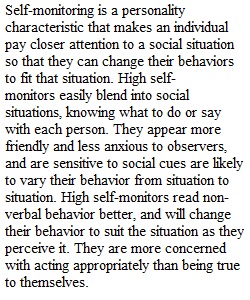


Q Attitudes are enduring behavioral and cognitive tendencies that are expressed by evaluating particular people, places, or things with favor or disfavor (Bohner & Dickel, 2011). Attitudes are largely learned, although people may have inborn predispositions to lean one way or another on issues (Kandler et al., 2014; Lewis & Bates, 2013). They can lead to social conflict or to the resolution of conflicts. Attitudes can change, but not easily. One concept that has been determined to play a part in how attitude determines behavior is the concept of self monitoring. Read the following article: Individual Differences in Predicting Behavioral Intentions from Attitude and Subjective Norm Download Individual Differences in Predicting Behavioral Intentions from Attitude and Subjective Norm, (DeBono and Omoto, 2001). The introduction discusses the difference between high and low self-monitors. In a 250-300 word reply, discuss the purpose of this research and explain the results. Reply to at least two other students in a 75-100 word response. Note: Click the options button in the upper right corner to see the rubric for this exercise.
View Related Questions